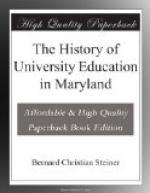I see no advantage in our attempting to maintain the traditional four-year class-system of the American colleges. It has never existed in the University of Virginia; it is modified, though not nominally given up at Harvard; it is not an important characteristic of Michigan and Cornell; it is not known in the English, French or German universities. It is a collegiate rather than a university method. If parents or students desire us to mark out prescribed courses, either classical or scientific, lasting four years, it will be easy to do so. But I apprehend that many students will come to us excellent in some branches of a liberal education and deficient in others—good perhaps in Greek, Latin and mathematics; deficient in chemistry, physics, zoology, history, political economy, and other progressive sciences. I would give to such candidates on examination, credit for their attainments, and assign them in each study the place for which they are fitted. A proficient in Plato may be a tyro in Euclid. Moreover, I would make attainments rather than time the condition of promotion; and I would encourage every scholar to go forward rapidly or go forward slowly, according to the fleetness of his foot and his freedom from impediment. In other words, I would have our University seek the good of individuals rather than of classes.
The sphere of a university is sometimes restricted by its walls or is limited to those who are enrolled on its lists. There are three particulars in which we shall aim at extramural influence: first, as an examining body, ready to examine and confer degrees or other academic honors on those who are trained elsewhere; next, as a teaching body, by opening to educated persons (whether enrolled as students or not) such lectures as they may wish to attend, under certain restrictions—on the plan of the lectures in the high seminaries of Paris; and, finally, as in some degree at least a publishing body, by encouraging professors and lecturers to give to the world in print the results of their researches.
What are we aiming at?
An enduring foundation; a slow development; first local, then regional, then national influence; the most liberal promotion of all useful knowledge; the special provision of such departments as are elsewhere neglected in the country; a generous affiliation with all other institutions, avoiding interferences, and engaging in no rivalry; the encouragement of research; the promotion of young men; and the advancement of individual scholars, who by their excellence will advance the sciences they pursue, and the society where they dwell.
No words could indicate our aim more fitly than those by which John Henry Newman expresses his “Idea of the University,” in a page glowing with enthusiasm, to which I delight to revert.
What will be our agencies?
A large staff of teachers; abundance of instruments, apparatus, diagrams, books, and other means of research and instruction; good laboratories, with all the requisite facilities; accessory influences, coming both from Baltimore and Washington; funds so unrestricted, charter so free, schemes so elastic, that as the world goes forward, our plans will be adjusted to its new requirements.




